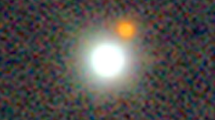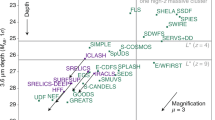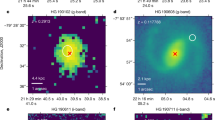Abstract
A fundamental prediction of relativistic cosmologies is that, owing to the expansion of space, observations of the distant cosmos should be time dilated and appear to run slower than events in the local universe. While observations of cosmological supernovae unambiguously show the expected redshift-dependent time dilation, this has not been the case for other distant sources. Here we present the identification of cosmic time dilation in a sample of 190 quasars monitored for over two decades in multiple wavebands by assessing various hypotheses through Bayesian analysis. This detection counters previous claims that observed quasar variability lacked the expected redshift-dependent time dilation. Hence, as well as dismissing the claim that the apparent lack of the redshift dependence of quasar variability represents a substantial challenge to the standard cosmological model, this analysis further indicates that the properties of quasars are consistent with them being truly cosmologically distant sources.
This is a preview of subscription content, access via your institution
Access options
Access Nature and 54 other Nature Portfolio journals
Get Nature+, our best-value online-access subscription
$29.99 / 30 days
cancel any time
Subscribe to this journal
Receive 12 digital issues and online access to articles
$119.00 per year
only $9.92 per issue
Buy this article
- Purchase on Springer Link
- Instant access to full article PDF
Prices may be subject to local taxes which are calculated during checkout



Similar content being viewed by others
Data availability
The source data for this project are available at https://zenodo.org/record/5842449#.YipOg-jMJPY, with the details of the available FITS tables presented in ref. 27. Note that a revised version of this catalogue was recently released due to an error in some rest-frame quantities. This revision does not impact any of the research presented in this paper. The software for this project is available at https://github.com/eggplantbren/QuasarTimeDilation.
Code availability
This project made use of several publicly available software packages, especially DNest436 to undertake the exploration of the posterior probability space and calculate the Bayesian evidence by integrating across this space. Further software packages employed include matplotlib39, numpy40 and scipy41. Initial explorations of the posterior probability space were undertaken with emcee with corner plots prepared with corner42. The software employed as part of this project will be made available on reasonable request to the corresponding author.
References
Lemaître, G. et al. Un Univers homogène de masse constante et de rayon croissant rendant compte de la vitesse radiale des nébuleuses extra-galactiques. Ann. Soc. Sci. Bruxelles 47, 49–59 (1927).
Lemaître, G. et al. A homogeneous universe of constant mass and increasing radius accounting for the radial velocity of extra-galactic nebulae. Mon. Not. R. Astron. Soc. 91, 483–490 (1931).
Wilson, O. C. Possible applications of supernovae to the study of the nebular red shifts. Astrophys. J. 90, 634 (1939).
Leibundgut, B. et al. Time dilation in the light curve of the distant type IA supernova SN 1995K. Astrophys. J. Lett. 466, L21 (1996).
Riess, A. G. et al. Time dilation from spectral feature age measurements of type IA supernovae. Astron. J. 114, 722–729 (1997).
Goldhaber, G. et al. Timescale stretch parameterization of type Ia supernova B-band light curves. Astrophys. J. 558, 359–368 (2001).
Foley, R. J. et al. A definitive measurement of time dilation in the spectral evolution of the moderate-redshift type Ia supernova 1997ex. Astrophys. J. Lett. 626, L11–L14 (2005).
Blondin, S. et al. Time dilation in type Ia supernova spectra at high redshift. Astrophys. J. 682, 724–736 (2008).
Norris, J. P. et al. Detection of signature consistent with cosmological time dilation in gamma-ray bursts. Astrophys. J. 424, 540 (1994).
Kocevski, D. & Petrosian, V. On the lack of time dilation signatures in gamma-ray burst light curves. Astrophys. J. 765, 116 (2013).
Zhang, F.-W., Fan, Y.-Z., Shao, L. & Wei, D.-M. Cosmological time dilation in durations of swift long gamma-ray bursts. Astrophys. J. Lett. 778, L11 (2013).
Littlejohns, O. M. & Butler, N. R. Investigating signatures of cosmological time dilation in duration measures of prompt gamma-ray burst light curves. Mon. Not. R. Astron. Soc. 444, 3948–3960 (2014).
Singh, A. & Desai, S. Search for cosmological time dilation from gamma-ray bursts—a 2021 status update. J. Cosmol. Astropart. Phys. 2022, 010 (2022).
Petroff, E., Hessels, J. W. T. & Lorimer, D. R. Fast radio bursts at the dawn of the 2020s. Astron. Astrophy. Rev. 30, 2 (2022).
Zhang, B. The physics of fast radio bursts. Preprint at arXiv https://doi.org/10.48550/arXiv.2212.03972 (2022).
Schmidt, M. 3C 273: a star-like object with large red-shift. Nature 197, 1040 (1963).
Salpeter, E. E. Accretion of interstellar matter by massive objects. Astrophys. J. 140, 796–800 (1964).
Hawkins, M. R. S. Gravitational microlensing, quasar variability and missing matter. Nature 366, 242–245 (1993).
Hawkins, M. R. S. Time dilation and quasar variability. Astrophys. J. Lett. 553, L97–L100 (2001).
Hawkins, M. R. S. On time dilation in quasar light curves. Mon. Not. R. Astron. Soc. 405, 1940–1946 (2010).
Hawkins, M. R. S. & Taylor, A. N. Quasar variability and gravitational microlensing. Astrophys. J. Lett. 482, L5–L8 (1997).
Hawkins, M. R. S. New evidence for a cosmological distribution of stellar mass primordial black holes. Mon. Not. R. Astron. Soc. 512, 5706–5714 (2022).
Chashchina, O. I. & Silagadze, Z. K. Expanding space, quasars and St. Augustine’s fireworks. Universe 1, 307–356 (2015).
López-Corredoira, M. Tests and problems of the standard model in cosmology. Found. Phys. 47, 711–768 (2017).
Crawford, D. F. A problem with the analysis of type Ia supernovae. Open Astron. 26, 111–119 (2017).
Dai, D.-C., Starkman, G. D., Stojkovic, B., Stojkovic, D. & Weltman, A. Using quasars as standard clocks for measuring cosmological redshift. Phys. Rev. Lett. 108, 231302 (2012).
Stone, Z. et al. Optical variability of quasars with 20-yr photometric light curves. Mon. Not. R. Astron. Soc. 514, 164–184 (2022).
Shen, Y. et al. A catalog of quasar properties from Sloan Digital Sky Survey Data Release 7. Astrophys. J. Suppl. Ser. 194, 45 (2011).
Richards, G. T. et al. Spectral energy distributions and multiwavelength selection of type 1 quasars. Astrophys. J. Suppl. Ser. 166, 470 (2006).
Aigrain, S. & Foreman-Mackey, D. Gaussian process regression for astronomical time-series. Preprint at arXiv https://doi.org/10.48550/arXiv.2209.08940 (2022).
Kelly, B. C., Bechtold, J. & Siemiginowska, A. Are the variations in quasar optical flux driven by thermal fluctuations? Astrophys. J. 698, 895–910 (2009).
Sheng, X., Ross, N. & Nicholl, M. Legacy Survey of Space and Time cadence strategy evaluations for active galactic nucleus time-series data in Wide-Fast-Deep field. Mon. Not. R. Astron. Soc. 512, 5580–5600 (2022).
Suberlak, K. L., Ivezić, Ž. & MacLeod, C. Improving damped random walk parameters for SDSS Stripe 82 quasars with Pan-STARRS1. Astrophys. J. 907, 96 (2021).
Foreman-Mackey, D., Agol, E., Angus, R. & Ambikasaran, S. Fast and scalable gaussian process modeling with applications to astronomical time series. Astron. J. 154, 220 (2017).
Kass, R. E. & Raftery, A. E. Bayes factors. J. Am. Stat. Assoc. 90, 773–795 (1995).
Brewer, B. J. & Foreman-Mackey, D. DNest4: diffusive nested sampling in C++ and Python. J. Stat. Softw. 86, 1–33 (2018).
Skilling, J. Nested sampling. AIP Conf. Proc. 735, 395–405 (2004).
Sanejouand, Y.-H. A framework for the next generation of stationary cosmological models. Int. J. Mod. Phys. D 31, 2250084 (2022).
Hunter, J. D. Matplotlib: a 2D graphics environment. Comput. Sci. Eng. 9, 90–95 (2007).
Harris, C. R. et al. Array programming with NumPy. Nature 585, 357–362 (2020).
Virtanen, P. et al. SciPy 1.0: fundamental algorithms for scientific computing in Python. Nat. Methods 17, 261–272 (2020).
Foreman-Mackey, D. corner.py: scatterplot matrices in Python. J. Open Source Softw. 1, 24 (2016).
Acknowledgements
We thank Z. Stone et al.27 for making their data and the results of their analysis publicly available. We also thank S. Croom for his input and advice on quasar variability surveys. We further thank the teams responsible for creating and maintaining the various software packages, detailed below, that this study has employed. G.F.L. thanks the hospitality of the Lowell Observatory where the last stages of this work were completed during a period of isolation due to the contraction of COVID-19.
Author information
Authors and Affiliations
Contributions
The project was conceived by G.F.L., including an initial exploration of the data, the definition of the models and hypotheses considered, the likelihood function and sampling of the posterior space. B.J.B. undertook detailed sampling and calculating the Bayesian evidence using DNest4. Both authors discussed the results of the exploration in detail, determined the resulting conclusion and were responsible for the writing of the paper.
Corresponding author
Ethics declarations
Competing interests
The authors declare no competing interests.
Peer review
Peer review information
Nature Astronomy thanks Deborah Dultzin and the other, anonymous, reviewer(s) for their contribution to the peer review of this work.
Additional information
Publisher’s note Springer Nature remains neutral with regard to jurisdictional claims in published maps and institutional affiliations.
Rights and permissions
Springer Nature or its licensor (e.g. a society or other partner) holds exclusive rights to this article under a publishing agreement with the author(s) or other rightsholder(s); author self-archiving of the accepted manuscript version of this article is solely governed by the terms of such publishing agreement and applicable law.
About this article
Cite this article
Lewis, G.F., Brewer, B.J. Detection of the cosmological time dilation of high-redshift quasars. Nat Astron 7, 1265–1269 (2023). https://doi.org/10.1038/s41550-023-02029-2
Received:
Accepted:
Published:
Issue Date:
DOI: https://doi.org/10.1038/s41550-023-02029-2
This article is cited by
-
An evolution of the universe based on a modified time-redshift relation can avoid the introduction of a cosmological constant
Astrophysics and Space Science (2024)



